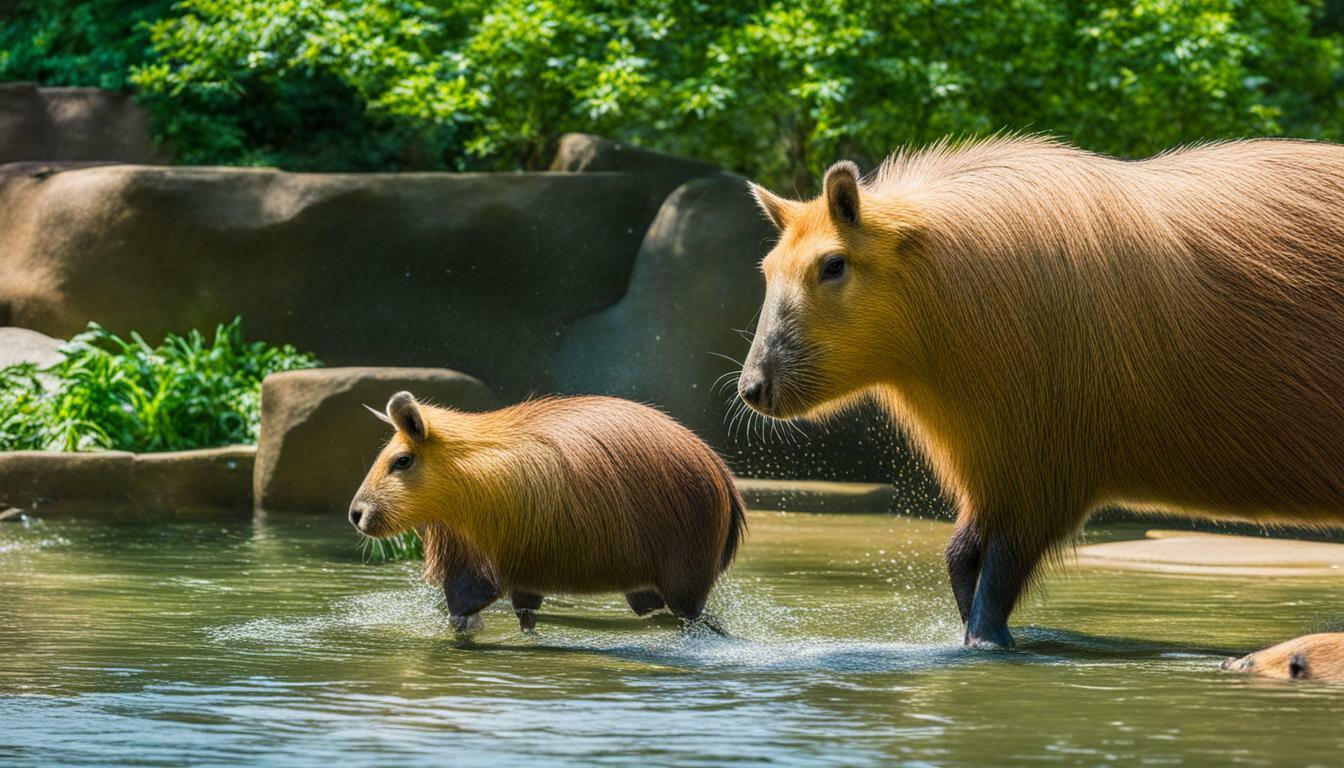Are capybaras a part of the Philadelphia Zoo’s animal collection? No, the Philadelphia Zoo does not have capybaras. However, there are other nearby zoos where you can see them, such as the Lehigh Valley Zoo, the Elmwood Park Zoo, and the Pittsburgh Zoo. The Philadelphia Zoo used to have capybaras in the early 2000s but removed them in 2011 due to space constraints. Capybaras are the world’s largest rodents and are known for their friendly and social behavior. While the Philadelphia Zoo doesn’t have capybaras, they have other animals closely related to them, such as agoutis.
Key Takeaways:
- The Philadelphia Zoo does not have capybaras in its animal collection.
- There are other nearby zoos in the Philadelphia area where you can see capybaras, such as the Lehigh Valley Zoo, Elmwood Park Zoo, and Pittsburgh Zoo.
- The Philadelphia Zoo used to have capybaras in the past but removed them in 2011 due to space constraints.
- Capybaras are the world’s largest rodents and are known for their friendly and social behavior.
- While capybaras are not present, the Philadelphia Zoo has other animals closely related to them, such as agoutis.
History of Capybaras at the Philadelphia Zoo
The Philadelphia Zoo has a long history of housing diverse animal species, but what about capybaras? Despite their absence now, the Philadelphia Zoo did have capybaras in the early 2000s. These fascinating rodents were a popular attraction for visitors, known for their friendly and social behavior.
However, due to space constraints and the need to prioritize other species, the Philadelphia Zoo made the difficult decision to remove the capybaras in 2011. This allowed the zoo to focus on providing optimal habitats for a variety of animals while ensuring their well-being.
Although capybaras are no longer found at the Philadelphia Zoo, there are other nearby zoos where you can see these curious creatures. The Lehigh Valley Zoo, Elmwood Park Zoo, and Pittsburgh Zoo all have capybara exhibits that offer visitors the chance to observe and learn about these unique rodents up close.
| Zoo | Capybara Exhibit |
|---|---|
| Lehigh Valley Zoo | Yes |
| Elmwood Park Zoo | Yes |
| Pittsburgh Zoo | Yes |
The Lehigh Valley Zoo
Located just outside of Allentown, the Lehigh Valley Zoo is home to an enchanting capybara exhibit. Visitors can watch these creatures as they swim, play, and interact with each other. This immersive experience allows you to appreciate the capybaras’ intriguing characteristics and observe their social dynamics.
The Elmwood Park Zoo
In Norristown, the Elmwood Park Zoo also offers visitors the opportunity to see capybaras. The zoo’s capybara exhibit provides a glimpse into the natural behavior and habitat of these remarkable rodents. You can witness their large size and unique features, making for an educational and enjoyable visit.
The Pittsburgh Zoo
For those willing to venture further, the Pittsburgh Zoo is another excellent destination to encounter capybaras. Their capybara exhibit showcases these gentle giants in a spacious and naturalistic setting. You can observe their laid-back demeanor and learn more about their role in the animal kingdom.
Capybaras at Nearby Zoos
If you’re eager to see capybaras in the Philadelphia area, there are alternative options available. The Philadelphia Zoo may not currently have capybaras, but you can visit other nearby zoos that feature these fascinating rodents. Two such zoos are the Lehigh Valley Zoo and the Elmwood Park Zoo, both located within a reasonable driving distance from Philadelphia.
Lehigh Valley Zoo
Located in Schnecksville, Pennsylvania, the Lehigh Valley Zoo is home to a variety of animal species, including capybaras. You can observe these friendly and sociable creatures up close and learn more about their behavior and habitat. The zoo offers a unique opportunity to experience the thrill of seeing capybaras in a naturalistic setting.
Elmwood Park Zoo
The Elmwood Park Zoo in Norristown, Pennsylvania, is another great option to see capybaras. This family-friendly zoo is known for its diverse collection of animals and provides visitors with an opportunity to get a glimpse of these impressive rodents. You can explore their capybara exhibit and discover interesting facts about their unique characteristics.
If you’re willing to venture a little further, the Pittsburgh Zoo in Pittsburgh, Pennsylvania, is another fantastic zoo that houses capybaras. Alongside capybaras, you can also see a wide range of other animal species, making it a worthwhile excursion for animal enthusiasts.
So, while the Philadelphia Zoo may not currently have capybaras, you can still satisfy your desire to see these fascinating creatures by visiting the Lehigh Valley Zoo, the Elmwood Park Zoo, or the Pittsburgh Zoo. Plan a day trip to one of these nearby zoos and embark on an exciting adventure to witness capybaras up close and personal.
| Zoo | Location |
|---|---|
| Lehigh Valley Zoo | Schnecksville, Pennsylvania |
| Elmwood Park Zoo | Norristown, Pennsylvania |
| Pittsburgh Zoo | Pittsburgh, Pennsylvania |
Philadelphia Zoo’s Capybara Removal
Although capybaras were once part of the Philadelphia Zoo, they are no longer present. The zoo made the difficult decision to remove the capybaras from their collection in 2011 due to space constraints and the need to prioritize other species. While it is unfortunate that visitors can no longer see capybaras at the Philadelphia Zoo, there are alternative options available nearby.
If you’re eager to encounter these fascinating creatures, you can visit the Lehigh Valley Zoo, the Elmwood Park Zoo, or the Pittsburgh Zoo. These zoos have capybara exhibits where you can observe these largest rodents in the world in all their glory. The Lehigh Valley Zoo, located just a short drive from Philadelphia, offers a unique opportunity to learn about capybaras and their natural habitats.
Although the Philadelphia Zoo no longer has capybaras, they do have other animals that are closely related to them. Agoutis, which resemble smaller versions of capybaras, can be found at the Philadelphia Zoo. These agoutis exhibit similar behavior and characteristics to their larger relatives, providing visitors with an intriguing glimpse into the world of capybaras.
| Zoo | Location | Capybara Exhibit |
|---|---|---|
| Lehigh Valley Zoo | Lehigh Valley, PA | Yes |
| Elmwood Park Zoo | Norristown, PA | Yes |
| Pittsburgh Zoo | Pittsburgh, PA | Yes |
So, while the Philadelphia Zoo may not have capybaras anymore, you can still have a wonderful animal-filled experience by visiting nearby zoos that offer capybara encounters. Whether you choose to explore the Lehigh Valley Zoo, the Elmwood Park Zoo, or the Pittsburgh Zoo, you’ll have the opportunity to observe these fascinating creatures up close and learn more about their habitats and behaviors.
Capybaras, the World’s Largest Rodents
Capybaras are fascinating creatures that capture the attention of many zoo visitors. Known as the largest rodents in the world, these large, barrel-shaped animals have a unique charm that sets them apart. At the Philadelphia Zoo, you won’t find capybaras currently, but there are plenty of other captivating species to discover.
Capybaras are native to South America, where they inhabit a range of habitats including wetlands, swamps, and grassy areas. They are excellent swimmers and spend a significant amount of time in the water to cool off and find food. With their webbed feet and streamlined bodies, capybaras are well-adapted to their semi-aquatic lifestyle.
These social creatures are often seen in groups called “herds” or “capybara mobs.” They have a friendly and gentle nature, which makes them a favorite among zoo visitors. Capybaras are known to engage in communal grooming, where they help each other maintain cleanliness by nibbling on each other’s fur.
| Capybara Facts | Capybara Species |
|---|---|
| Capybaras are herbivores, primarily feeding on aquatic plants, grasses, and fruits. | There is only one species of capybara: Hydrochoerus hydrochaeris. |
| Capybaras have a lifespan of around 8-12 years in the wild and up to 15 years in captivity. | They belong to the family Caviidae, which also includes guinea pigs and rock cavies. |
| They have unique adaptations for their semi-aquatic lifestyle, including eyes, ears, and nostrils positioned on top of their head. | Capybaras are excellent swimmers and can stay submerged for several minutes at a time. |
While the Philadelphia Zoo may not currently have capybaras, they do have other fascinating animals that you can explore. Take a stroll through the zoo to encounter a diverse range of species and learn more about the incredible world of wildlife.
Philadelphia Zoo’s Animal Collection
Although capybaras are not part of the Philadelphia Zoo’s animal collection, there are still plenty of other incredible creatures to discover. The zoo is home to a diverse range of species from all around the world, providing visitors with a unique opportunity to learn about and observe fascinating animals up close.
One of the highlights of the Philadelphia Zoo is its Big Cat Falls exhibit, where you can encounter majestic predators like lions, tigers, and jaguars. Walking through this immersive habitat, you’ll get a sense of the awe-inspiring power and beauty of these magnificent creatures.
For those interested in primates, the PECO Primate Reserve is an absolute must-visit. This exhibit showcases a variety of primates, including gorillas, orangutans, and lemurs. Observing these intelligent and highly adaptive animals in their naturalistic habitats offers a glimpse into their complex social structures and behaviors.
| Exhibit | Interesting Animals |
|---|---|
| McNeil Avian Center | Flamingos, hornbills, owls, and more |
| Creatures of Habitat | Meerkats, sloths, bush dogs, and more |
| Reptile and Amphibian House | Snakes, turtles, frogs, and more |
Another popular attraction is the McNeil Avian Center, which houses a wide variety of bird species. From vibrant flamingos to exotic hornbills, this exhibit showcases the incredible diversity of avian life.
The Creatures of Habitat exhibit is also worth exploring, featuring animals such as meerkats, sloths, and bush dogs. This immersive experience allows you to observe these unique creatures in habitats that are designed to mimic their natural environments.
If reptiles and amphibians pique your interest, the Reptile and Amphibian House is a must-see. Here, you’ll find an array of fascinating creatures, including snakes, turtles, and frogs. This exhibit provides an opportunity to learn more about these often-misunderstood animals and appreciate their important role in ecosystems.
Although capybaras may not be present, the Philadelphia Zoo’s animal collection offers an incredible and educational experience for visitors of all ages. Whether you’re interested in big cats, primates, birds, or reptiles, there’s something for everyone to enjoy and discover at the Philadelphia Zoo.
Agoutis, Relatives of Capybaras at the Philadelphia Zoo
While you won’t find capybaras at the Philadelphia Zoo, there is another rodent species that may catch your attention – agoutis. These fascinating creatures are closely related to capybaras and share many characteristics. Agoutis are known for their slender bodies, long legs, and short ears, which make them agile and well-adapted to their natural habitats. Their fur can vary in color, ranging from reddish-brown to dark brown, providing excellent camouflage in the forest undergrowth.
At the Philadelphia Zoo, you can observe the playful and curious nature of agoutis in their exhibit. These rodents are highly active during the day, often foraging for food and exploring their surroundings. Visitors can witness their superb agility as they navigate through branches and climb trees with ease.
| Agoutis at Philadelphia Zoo | Features |
|---|---|
| Species | Red-rumped Agouti, Crested Agouti |
| Habitat | Forests, grasslands, and scrublands |
| Diet | Fruits, nuts, seeds, and vegetation |
| Behavior | Playful, social, and diurnal |
These social creatures often live in small groups and communicate through a variety of vocalizations and scent marking. Agoutis are herbivores, feeding on fruits, nuts, seeds, and vegetation. Their diet plays a vital role in seed dispersal and contributes to the health of their forest habitats.
So, while capybaras may not call the Philadelphia Zoo home, a visit to observe the agoutis offers a delightful alternative. Exploring the exhibit allows you to appreciate the natural behaviors and unique characteristics of these fascinating rodent species.
Exploring Capybara Habitats
Capybaras thrive in specific habitats, which contribute to their distinct behaviors and adaptations. These fascinating creatures are native to South America, where they can be found in a variety of environments, including swamps, marshes, and grasslands. Their semi-aquatic nature makes them well-suited to these watery habitats, as they are excellent swimmers and can even hold their breath underwater for several minutes.
In their natural habitats, capybaras form social groups known as herds, which can consist of up to 30 individuals. These herds provide protection and enable them to navigate their surroundings effectively. Capybaras are herbivores, and their diets primarily consist of grasses, aquatic plants, and even tree bark. Their unique digestion system allows them to extract nutrients from the tough plant materials they consume.
While the Philadelphia Zoo does not have capybaras, they do provide visitors with the opportunity to learn about these fascinating animals and their habitats. Through educational exhibits and displays, visitors can gain a deeper understanding of capybara behavior, their role in ecosystems, and the importance of preserving their natural habitats.
| Characteristic | Description |
|---|---|
| Size | Capybaras are the world’s largest rodents, with adults reaching lengths of up to 4 feet and weighing between 77 to 146 pounds. |
| Behavior | These social creatures are known for their friendly and peaceful nature, often forming close bonds with each other and other species. |
| Adaptations | Their webbed feet and slightly webbed toes enable capybaras to navigate through water with ease, making them skilled swimmers. |
Threats to Capybara Habitats
Despite their adaptability, capybaras face threats in the form of habitat loss and fragmentation due to human activities such as deforestation and urbanization. As their natural habitats diminish, it becomes increasingly crucial to support conservation efforts that aim to protect and restore these environments.
- Promoting sustainable land management practices to preserve the natural habitats of capybaras and other species.
- Supporting organizations and initiatives dedicated to conserving capybara populations and their ecosystems.
- Encouraging responsible tourism that promotes education, awareness, and respect for capybaras and their habitats.
By taking these steps, we can help ensure the continued survival and well-being of capybaras and the diverse ecosystems they inhabit.
Capybara Conservation Efforts
Capybaras, like many other species, require conservation efforts to ensure their long-term survival. These fascinating creatures are native to South America and are found in various countries such as Brazil, Argentina, and Venezuela. Their habitats, which include swamps, marshes, and riverbanks, are under threat due to urbanization, deforestation, and agriculture.
To protect capybaras and their natural habitats, organizations and zoos around the world are actively involved in conservation initiatives. For instance, the Philadelphia Zoo plays a crucial role in raising awareness about these animals and the challenges they face. Through educational programs, exhibits, and research, they help promote a better understanding of capybaras and the importance of their conservation.
Additionally, international conservation organizations work collaboratively to develop strategies for preserving capybara populations. They focus on habitat conservation, rehabilitation, and raising public awareness. These efforts aim to safeguard capybaras and their ecosystems by addressing the various threats they encounter.
| Conservation Efforts | Description |
|---|---|
| Habitat Preservation | Efforts to protect and restore capybara habitats, ensuring they have suitable environments to thrive in. |
| Research and Monitoring | Studying capybara populations and their behaviors to gather valuable data for conservation purposes. |
| Community Involvement | Engaging local communities in conservation efforts, promoting sustainable practices, and reducing human-wildlife conflicts. |
| Legislation and Policy | Advocating for protective measures and regulations to safeguard capybaras and their habitats. |
By supporting these conservation efforts, we can all contribute to ensuring the long-term survival of capybaras and protecting the delicate balance of ecosystems they inhabit.
Capybara Encounters at Other Zoos
If you’re eager for a hands-on experience with capybaras, there may be opportunities at other zoos. While the Philadelphia Zoo doesn’t currently have capybaras, you can visit the Lehigh Valley Zoo, the Elmwood Park Zoo, or the Pittsburgh Zoo to see these fascinating creatures up close.
The Lehigh Valley Zoo, located in Schnecksville, Pennsylvania, offers a unique chance to interact with capybaras. Their “Capybara Encounter” allows you to get an up-close look at these friendly and social rodents. You’ll learn about their behavior, diet, and habitat while enjoying a memorable experience.
At the Elmwood Park Zoo in Norristown, Pennsylvania, you can also meet capybaras. The zoo’s “Capybara Encounter” provides an opportunity to interact with these playful creatures under the guidance of knowledgeable staff. It’s a great way to learn more about their characteristics and conservation efforts.
| Zoo | Location | Capybara Encounter |
|---|---|---|
| Lehigh Valley Zoo | Schnecksville, PA | Yes |
| Elmwood Park Zoo | Norristown, PA | Yes |
| Pittsburgh Zoo | Pittsburgh, PA | No |
Please note that while the Pittsburgh Zoo in Pittsburgh, Pennsylvania, does not currently offer a capybara encounter, it still has a variety of other captivating animals for you to explore.
If you’re looking to spend time with capybaras during your zoo visit, consider heading to the Lehigh Valley Zoo or the Elmwood Park Zoo. These experiences allow you to get up close and personal with these fascinating rodents, learning more about their behavior and conservation efforts. Remember to check the zoos’ websites for specific details and availability before planning your visit.
Other Unique Animals at the Philadelphia Zoo
While capybaras may not be present, the Philadelphia Zoo boasts a wide range of captivating and unique animal species. Visitors to the zoo can explore an incredible array of creatures from all corners of the globe. One of the most popular attractions is the rare and majestic Amur leopard, one of the world’s most endangered big cats. These elusive and beautiful creatures can be seen in their specially designed habitat, offering visitors a glimpse into the splendor of the animal kingdom.
In addition to the Amur leopard, the Philadelphia Zoo is home to the adorable red panda. These charming creatures, known for their vibrant red fur and bushy tails, captivate visitors of all ages. Watching them climb and play in their tree-filled habitat is a true delight.
Another unique animal at the Philadelphia Zoo is the Okapi, often referred to as the “forest giraffe.” These elusive creatures, native to the rainforests of central Africa, are known for their striking appearance, with zebra-like stripes on their hindquarters and a long, flexible tongue that allows them to reach leaves and plants high in the trees.
| Animal | Location | Habitat |
|---|---|---|
| Amur leopard | Big Cat Falls | Forests of Russia and China |
| Red panda | First Niagara Big Cat Falls | Himalayan forests |
| Okapi | African Plains | Central African rainforests |
These are just a few examples of the incredible animals you can encounter at the Philadelphia Zoo. From towering giraffes to playful primates, every visit to the zoo is an opportunity to learn about and appreciate the diverse and unique species that inhabit our planet.
Conclusion
Although the Philadelphia Zoo does not house capybaras, there are still opportunities to observe these incredible creatures nearby. The zoo used to have capybaras in the early 2000s, but they were removed in 2011 due to space constraints. However, if you’re eager to see these fascinating rodents up close, you can visit other zoos in the area.
The Lehigh Valley Zoo, Elmwood Park Zoo, and Pittsburgh Zoo are just a short drive away and are home to capybara exhibits. These zoos provide a chance to marvel at the world’s largest rodents and learn more about their unique characteristics and behavior.
While the Philadelphia Zoo might not have capybaras, they do have other animals that are closely related to them. Agoutis, another fascinating rodent species, can be found at the Philadelphia Zoo. These agile creatures share similar traits with capybaras and offer an exciting opportunity to observe their behavior and interactions.
So, even though capybaras may not be present at the Philadelphia Zoo, you can still embark on a captivating journey to see them nearby. Whether you choose to visit the Lehigh Valley Zoo, Elmwood Park Zoo, or the Pittsburgh Zoo, you’ll have the chance to encounter these remarkable creatures and broaden your understanding of the animal kingdom.
FAQ
Does the Philadelphia Zoo have capybaras?
No, the Philadelphia Zoo does not have capybaras.
Are there other zoos near Philadelphia where I can see capybaras?
Yes, there are other nearby zoos where you can see capybaras, such as the Lehigh Valley Zoo, the Elmwood Park Zoo, and the Pittsburgh Zoo.
Did the Philadelphia Zoo used to have capybaras?
Yes, the Philadelphia Zoo used to have capybaras in the early 2000s but removed them in 2011 due to space constraints.
What are capybaras?
Capybaras are the world’s largest rodents and are known for their friendly and social behavior.
What animals at the Philadelphia Zoo are closely related to capybaras?
While the Philadelphia Zoo doesn’t have capybaras, they have other animals closely related to them, such as agoutis.




